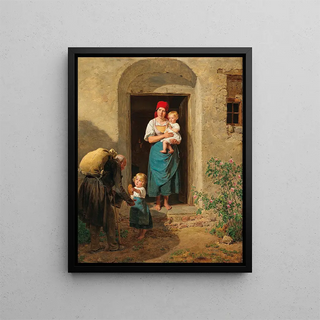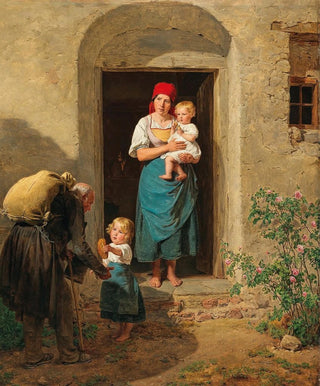Art print | L'enfant de bonne humeur - Ferdinand Georg Waldmüller


View from behind

Frame (optional)
The artwork "L'enfant de bonne humeur" by Ferdinand Georg Waldmüller is a true testament to the artistic sensitivity of the 19th century. This painting, imbued with light and joy, captures the very essence of childhood through the sparkling gaze of a young boy. Waldmüller, a master of realism, manages to convey a palpable emotion, inviting the viewer to share a moment of innocence and happiness. The scene depicted evokes a time when nature and children's innocence intertwine, offering a vision that is both nostalgic and delightful. This painting, a genuine ode to the joy of living, is a must-have for anyone interested in 19th-century art and how it reflects the aspirations and concerns of its era.
Style and uniqueness of the work
Waldmüller's style is characterized by meticulous attention to detail and skillful use of light. In "L'enfant de bonne humeur," vibrant colors and delicate contrasts create a warm and welcoming atmosphere. The face of the young boy, illuminated by sunlight, expresses an authentic joy that transcends the simple frame of the canvas. The artist succeeds in capturing not only the physical appearance of his subject but also the soul of childhood, its spontaneity and purity. The composition of the work, with its green background and natural elements, reinforces this connection between the child and his environment, demonstrating Waldmüller's ability to harmonize nature and humanity. Every brushstroke seems to tell a story, making the work both lively and timeless.
The artist and his influence
Ferdinand Georg Waldmüller, born in 1793 in Austria, is an emblematic figure of the realist movement. His career spans several decades, during which he captured the nuances of daily life and human emotions. Influenced by Romanticism, Waldmüller also distinguished himself through his unique approach, favoring familiar and accessible subjects. His work had a significant impact on Austrian painting and inspired many contemporary artists.

Matte finish

View from behind

Frame (optional)
The artwork "L'enfant de bonne humeur" by Ferdinand Georg Waldmüller is a true testament to the artistic sensitivity of the 19th century. This painting, imbued with light and joy, captures the very essence of childhood through the sparkling gaze of a young boy. Waldmüller, a master of realism, manages to convey a palpable emotion, inviting the viewer to share a moment of innocence and happiness. The scene depicted evokes a time when nature and children's innocence intertwine, offering a vision that is both nostalgic and delightful. This painting, a genuine ode to the joy of living, is a must-have for anyone interested in 19th-century art and how it reflects the aspirations and concerns of its era.
Style and uniqueness of the work
Waldmüller's style is characterized by meticulous attention to detail and skillful use of light. In "L'enfant de bonne humeur," vibrant colors and delicate contrasts create a warm and welcoming atmosphere. The face of the young boy, illuminated by sunlight, expresses an authentic joy that transcends the simple frame of the canvas. The artist succeeds in capturing not only the physical appearance of his subject but also the soul of childhood, its spontaneity and purity. The composition of the work, with its green background and natural elements, reinforces this connection between the child and his environment, demonstrating Waldmüller's ability to harmonize nature and humanity. Every brushstroke seems to tell a story, making the work both lively and timeless.
The artist and his influence
Ferdinand Georg Waldmüller, born in 1793 in Austria, is an emblematic figure of the realist movement. His career spans several decades, during which he captured the nuances of daily life and human emotions. Influenced by Romanticism, Waldmüller also distinguished himself through his unique approach, favoring familiar and accessible subjects. His work had a significant impact on Austrian painting and inspired many contemporary artists.






